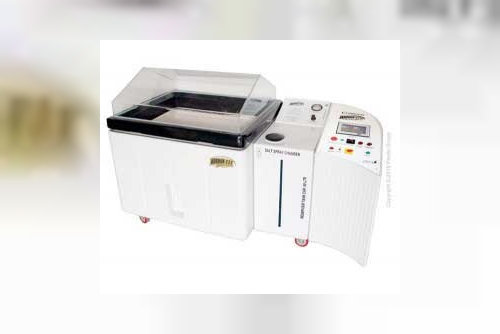In industries where materials face exposure to harsh environmental conditions, corrosion resistance is critical. The Salt Spray Chamber has become a widely used tool to test and measure the durability of materials, coatings, and surfaces. This testing equipment, also referred to as a salt spray test machine or salt spray corrosion chamber, simulates corrosive conditions that materials may encounter, helping manufacturers improve product quality and longevity.
This blog will explore what a salt spray chamber is, the salt spray test procedure, applications, and considerations such as salt spray chamber cost.
What is a Salt Spray Chamber?A salt spray chamber is an enclosed testing device used to expose samples to a controlled saline mist or fog environment. By simulating high-salt conditions, the chamber accelerates the corrosion process, revealing how materials, coatings, or paints react to corrosive conditions over time. This accelerated testing method allows industries such as automotive, aerospace, and marine to ensure their products can withstand long-term exposure to environmental elements.
The salt spray tester works by releasing a fine mist of salt solution into the chamber, maintaining a specific temperature and humidity level to mimic real-world conditions. This setup enables precise testing of corrosion resistance, helping companies produce more durable and reliable materials.
Salt Spray Test ProcedureThe salt spray test procedure is standardized to ensure reliable and repeatable results. The most widely followed guidelines are outlined in ASTM B117, ISO 9227, and JIS Z 2371. Here’s a basic overview of how the test works:
Preparation of the Sample: The material or coated sample is cleaned and prepared to avoid any contaminants that could affect the results. It is then placed inside the salt spray chamber.
Salt Solution Preparation: A salt solution is prepared using deionized water and a specific concentration of salt (typically 5% sodium chloride). This solution is then atomized inside the chamber.
Temperature and Humidity Control: The chamber maintains a temperature of around 35°C with controlled humidity. This stable environment allows consistent results across different test samples.
Exposure: The test sample is exposed to the salt mist for a specified duration, which can vary depending on the industry standards or product requirements. Testing times may range from hours to hundreds of hours, depending on the required level of corrosion resistance.
Evaluation: Once the test is complete, the sample is inspected for signs of corrosion, such as rust or pitting. Based on the results, manufacturers can assess whether the material meets the durability requirements.
Applications of Salt Spray TestingThe salt spray test is valuable in any industry where materials encounter corrosive environments, including:
Automotive: Ensuring car parts, from body panels to fasteners, resist rust in humid and salty environments.
Marine: Testing metals, paints, and coatings for boats and marine equipment, which are continuously exposed to salty conditions.
Construction: Verifying that structural components and coatings can withstand corrosion over time.
Aerospace: Confirming that aircraft components can resist corrosion, ensuring safety and reliability over long service periods.
Benefits of Salt Spray TestingEnhanced Durability: Salt spray testing identifies materials that can withstand long-term exposure to salty, humid environments, helping manufacturers select the best materials and coatings.
Cost Savings: Testing for corrosion resistance before production helps avoid expensive repairs or replacements due to early material failure.
Compliance: Many industries require strict adherence to durability standards, making salt spray chambers essential for meeting regulatory requirements.
Salt Spray Chamber CostThe salt spray chamber cost can vary widely depending on the size, features, and brand. Entry-level models with basic functionality may be suitable for small-scale testing, while larger, more advanced chambers with automated controls and extensive data logging capabilities may be needed for industrial use. Although the initial investment can be significant, a quality salt spray test machine offers long-term savings by reducing product recalls and ensuring higher durability.
Choosing the Right Salt Spray Corrosion ChamberWhen selecting a salt spray corrosion chamber, consider the following factors:
Size and Capacity: Choose a chamber that can accommodate the size and number of samples needed for your testing requirements.
Control Features: Advanced models offer precise control over temperature, humidity, and testing duration, ensuring more accurate results.
Data Logging and Analysis: Modern salt spray testers often include data logging and reporting features to streamline the analysis process.
Durability and Maintenance: Opt for a chamber made of corrosion-resistant materials to ensure long-term reliability and reduce maintenance needs.
Final ThoughtsSalt spray chambers play a critical role in corrosion testing by providing industries with a controlled environment to evaluate the durability of their materials. By understanding the salt spray test procedure and choosing the right salt spray corrosion chamber, companies can improve product quality, reduce failure risks, and meet industry standards. Whether it's a small business investing in basic equipment or a large manufacturer choosing a high-end salt spray tester, the insights gained from these tests contribute significantly to product reliability and customer satisfaction.












